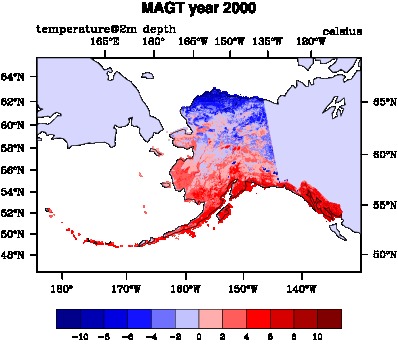Model:GIPL: Difference between revisions
No edit summary |
m (Text replacement - "{{End headertab}}" to "{{End headertab}} {{{{PAGENAME}}_autokeywords}}") |
||
| (68 intermediate revisions by 4 users not shown) | |||
| Line 1: | Line 1: | ||
{{Model identity | |||
|Model type=Single | |||
}} | |||
{{Start models incorporated}} | |||
{{End a table}} | |||
{{Model identity2 | |||
|ModelDomain=Terrestrial, Cryosphere | |||
|Spatial dimensions=1D | |||
|Spatialscale=Continental, Global, Landscape-Scale, Regional-Scale | |||
|One-line model description=GIPL(Geophysical Institute Permafrost Laboratory) is an implicit finite difference one-dimensional heat flow numerical model. | |||
|Extended model description=GIPL(Geophysical Institute Permafrost Laboratory) is an implicit finite difference one-dimensional heat flow numerical model. The GIPL model uses the effect of snow layer and subsurface soil thermal properties to simulate ground temperatures and active layer thickness (ALT) by solving the 1D heat diffusion equation with phase change. The phase change associated with freezing and thawing process occurs within a range of temperatures below 0 degree centigrade, and is represented by the unfrozen water curve (Romanovsky and Osterkamp 2000). The model employs finite difference numerical scheme over a specified domain. The soil column is divided into several layers, each with distinct thermo-physical properties. The GIPL model has been successfully used to map permafrost dynamics in Alaska and validated using ground temperature measurements in shallow boreholes across Alaska (Nicolsky et al. 2009, Jafarov et al. 2012, Jafarov et al. 2013, Jafarov et al. 2014). | |||
}} | |||
{{Start model keyword table}} | |||
{{Model keywords | |||
|Model keywords=heat flow | |||
}} | |||
{{Model keywords | |||
|Model keywords=permafrost | |||
}} | |||
{{End a table}} | |||
{{Modeler information | {{Modeler information | ||
|First name=Elchin | |First name=Elchin | ||
|Last name=Jafarov | |Last name=Jafarov | ||
|Institute / Organization= | |Type of contact=Model developer | ||
|Town / City= | |Institute / Organization=University of Colorado | ||
|Postal code= | |Town / City=Boulder | ||
| | |Postal code=80309 | ||
| | |Country=United States | ||
|Email address= | |State=Colorado | ||
}} | |Email address=Elchin.Jafarov@colorado.edu | ||
}} | |||
{{Model technical information | |||
|Supported platforms=Unix, Linux, Windows | |Supported platforms=Unix, Linux, Windows | ||
|Programming language=Fortran90, Matlab | |Programming language=Fortran90, Matlab | ||
|Code optimized=Single Processor, | |Code optimized=Single Processor, Multiple Processors | ||
|Start year development=2000 | |Start year development=2000 | ||
|Does model development still take place?=Yes | |Does model development still take place?=Yes | ||
|Model availability=As | |DevelopmentCode=As is, no updates are provided | ||
|Source code availability=Through | |DevelopmentCodeYearChecked=2020 | ||
|Model availability=As code | |||
|Source code availability=Through web repository | |||
|Source web address=https://github.com/Elchin/GIPL | |||
|Program license type=Other | |Program license type=Other | ||
|Typical run time=it takes less than a minite to run the serial model for one with daily time interval | |Typical run time=it takes less than a minite to run the serial model for one with daily time interval | ||
}} {{Input - Output description | }} | ||
{{Input - Output description | |||
|Describe input parameters=Upper Boundary (Air temperature) | |Describe input parameters=Upper Boundary (Air temperature) | ||
Lower Boundary (Temperature gradient) | Lower Boundary (Temperature gradient) | ||
| Line 47: | Line 62: | ||
|If above answer is yes=ESRI, Matlab | |If above answer is yes=ESRI, Matlab | ||
|Other visualization software=Matlab, Microsoft Excel (for serial); Matlab, ARCGIS, ncview (for spatial model) | |Other visualization software=Matlab, Microsoft Excel (for serial); Matlab, ARCGIS, ncview (for spatial model) | ||
}} {{Process description model | }} | ||
{{Process description model | |||
|Describe processes represented by the model=Main purpose of the model is to calculate subsurface temperature profile, active layer depth and freeze-up day. | |Describe processes represented by the model=Main purpose of the model is to calculate subsurface temperature profile, active layer depth and freeze-up day. | ||
|Describe key physical parameters and equations=Thermal capacities and conductivities prescribed for each subsurface layer, volumetric water content and unfrozen water coefficients. | |Describe key physical parameters and equations=Thermal capacities and conductivities prescribed for each subsurface layer, volumetric water content and unfrozen water coefficients. | ||
}} {{Model testing | }} | ||
{{Model testing | |||
|Describe available calibration data sets=We have tested the model for different permafrost observation sites for Alaska(USA) and Siberia(Russia). Typically, the model results show good correlation with measured data (if observations are accurate). | |Describe available calibration data sets=We have tested the model for different permafrost observation sites for Alaska(USA) and Siberia(Russia). Typically, the model results show good correlation with measured data (if observations are accurate). | ||
}} {{Users groups model}} {{Documentation model | |Model calibration data=Sample.zip, | ||
}} | |||
{{Users groups model}} | |||
{{Documentation model | |||
|Manual model available=No | |Manual model available=No | ||
}} {{Additional comments model}} | }} | ||
{{Additional comments model}} | |||
{{CSDMS staff part | |||
|OpenMI compliant=No but possible | |OpenMI compliant=No but possible | ||
|IRF interface=No but possible | |||
|CMT component=In progress | |||
|PyMT component=Yes | |||
|CCA component=No but possible | |CCA component=No but possible | ||
}} | |||
{{DOI information | |||
|DOI model=10.1594/IEDA/100131 | |||
}} {{ | |DOI assigned to model version=0.1 | ||
| | |DOI-year assigned to model version=2011 | ||
| | |DOI-filelink=https://csdms.colorado.edu/pub/models/doi-source-code/gipl-10.1594.IEDA.100131-0.1.tar.gz | ||
}} | |||
| | {{Start coupled table}} | ||
{{End a table}} | |||
{{End headertab}} | |||
{{{{PAGENAME}}_autokeywords}} | |||
| | |||
}} {{ | |||
}} {{ | |||
}} {{ | |||
}} {{ | |||
}} | |||
<!-- PLEASE USE THE "EDIT WITH FORM" BUTTON TO EDIT ABOVE CONTENTS; CONTINUE TO EDIT BELOW THIS LINE --> | |||
==== | == Introduction == | ||
GIPL(Geophysical Institute Permafrost Laboratory) is an implicit finite difference one-dimensional heat flow numerical model.The model uses fine vertical resolution grid which preserves the latent-heat effects in the phase transition zone, even under conditions of rapid or abrupt changes in the temperature fields. It includes upper boundary condition (usually air temperature), constant geothermal heat flux at the lower boundary (typically from 500 to 1000 m) and initial temperature distribution with depth. The other inputs are precipitation, prescribed water content and thermal properties of the multilayered soil column. As an output the model produces temperature distributions at different depths, active layer thickness and calculates time of freeze up. The results include temperatures at different depths and active layer thickness, freeze-up days. | |||
== | == IRF == | ||
== Issues == | == Issues == | ||
Does not include convective heat transfer. | |||
== | == Visualization == | ||
[[File:m22000.jpg]] | |||
== | == References == | ||
<br>{{AddReferenceUploadButtons}}<br><br> | |||
{{#ifexist:Template:{{PAGENAME}}-citation-indices|{{{{PAGENAME}}-citation-indices}}|}}<br> | |||
{{Include_featured_references_models_cargo}}<br> | |||
== | == Links == | ||
Latest revision as of 20:17, 16 September 2020
GIPL
Metadata
|
|
|
Introduction
GIPL(Geophysical Institute Permafrost Laboratory) is an implicit finite difference one-dimensional heat flow numerical model.The model uses fine vertical resolution grid which preserves the latent-heat effects in the phase transition zone, even under conditions of rapid or abrupt changes in the temperature fields. It includes upper boundary condition (usually air temperature), constant geothermal heat flux at the lower boundary (typically from 500 to 1000 m) and initial temperature distribution with depth. The other inputs are precipitation, prescribed water content and thermal properties of the multilayered soil column. As an output the model produces temperature distributions at different depths, active layer thickness and calculates time of freeze up. The results include temperatures at different depths and active layer thickness, freeze-up days.
IRF
Issues
Does not include convective heat transfer.
Visualization
References
| Nr. of publications: | 28 |
| Total citations: | 1146 |
| h-index: | 16 |
| m-quotient: | 0.8 |
| Featured publication(s) | Year | Model described | Type of Reference | Citations |
|---|---|---|---|---|
|
Jafarov, E E; Romanovsky, V E; Genet, H; McGuire, A D; Marchenko, S S; 2013. The effects of fire on the thermal stability of permafrost in lowland and upland black spruce forests of interior Alaska in a changing climate. Environmental Research Letters, 8, 035030. 10.1088/1748-9326/8/3/035030 (View/edit entry) | 2013 | GIPL |
Model application | 103 |
|
Sazonova, T. S.; Romanovsky, V. E.; 2003. A model for regional-scale estimation of temporal and spatial variability of active layer thickness and mean annual ground temperatures. Permafrost and Periglacial Processes, 14, 125–139. 10.1002/ppp.449 (View/edit entry) | 2003 | GIPL Kudryavtsev Model |
Related theory | 107 |
| See more publications of GIPL |


